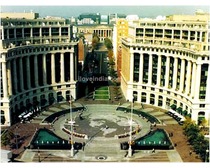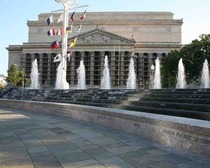The United States Navy Memorial commemorates the sailors who have served in the US Navy and other sea-related services. Read the article to find interesting and fun facts about the US Navy Memorial.
Facts About United States Navy Memorial
Spread across 100 foot diameter, the granite map of the world encircled by relief sculptural depictions of historic events in the US Naval history, the United States Navy Memorial is a marvelous masterpiece memorial. Located on Pennsylvania Avenue NW between the 7th Street Northwest and 9th Street Northwest in the capital city Washington DC, United States, the memorial is a tribute to all the servicemen who have served and are serving in the Navy, Marine Corps, Coast Guard and Merchant Marine. The entire memorial is surrounded by fountains, pools, flagpole masts and sculptural panels. The US Navy Memorial comprises of a commemorative public plaza and a Naval Heritage Center. Browse through the following lines to know more interesting and fun facts about this splendid and dazzling memorial. 

Interesting & Fun Facts About US Navy Memorial
-
A dream that was once envisioned by architect Pierre L’Enfant to honor the nation’s navy and its progress and achievements several centuries back was successfully realized in 1987 as United Stated Navy Memorial.
-
President John F. Kennedy, who himself a Navy war hero, inspired the redevelopment of Pennsylvania Avenue. But the actual momentum for the work on Navy Memorial started, when another Navy war hero, Admiral Arleigh Burke, proclaimed in 1977 that “we have talked long enough about a Navy Memorial and it's time we did something about it."
-
US Congress gave approval to the Memorial in 1980, with the condition that funding should come solely from private contributions.
-
A group of people were recruited to form a private, non-profit organization known as US Navy Memorial Foundation.
-
Several sites were taken into consideration for the construction of the memorial, but finalized the Market Square at Pennsylvania Avenue, after the Foundation joined hands with the Pennsylvania Avenue Development Corporation.
-
Construction of the memorial began in January 1986 and was completed with The Lone Sailor in August 1987. The statue was sculpted by Stanley Bleifeld.
-
The Lone Sailor is the symbolic statue that stands at the edge of the plaza. This sculpted statue represents all the sailors who have served, are serving and yet to serve in the Navy and other sea services.
-
Between 1987 and 1990, two other buildings were built on the memorial’s northern perimeter. The building on the eastern side was chosen for the Memorial’s Visitors Center.
-
The public plaza that forms a part of the memorial is a round ceremonial amphitheater, prepared in granite, housing a 100-foot diameter map of the world.
-
The classical building of Naval Heritage Center is the second part of the memorial. The Homecoming Statue is another majestic and applauding piece of sculpture that welcomes the guests, as they enter the center. The statue depicts the joyous reunion of a sailor, wife and child.
-
The Naval Heritage Center is home to the Arleigh Burke Theater that displays various artifacts about the sea services and many other Navy Log kiosks.
-
Two short films, the award-winning ‘At Sea’ and Discovery Channel’s ‘A Day in the Life of the Blue Angels’, are screened several times daily at the theater.
-
The center also has a library and media resource center of site, which has a collection of over 1,000 books and periodical titles, 30,000 photographs, 1,500 voice entries and various multimedia products.


See also
More from iloveindia.com
- Home Remedies | Ayurveda | Vastu | Yoga | Feng Shui | Tattoos | Fitness | Garden | Nutrition | Parenting | Bikes | Cars | Baby Care | Indian Weddings | Festivals | Party ideas | Horoscope 2015 | Pets | Finance | Figures of Speech | Hotels in India : Delhi | Hyderabad | Chennai | Mumbai | Kolkata | Bangalore | Ahmedabad | Jaipur
- Contact Us Careers Disclaimer Privacy Policy Advertise With Us Lifestyle Sitemap Copyright iloveindia.com. All Rights Reserved.







